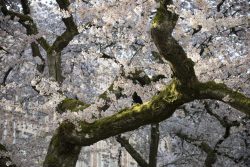
Though Seattle’s weather can be fickle in the spring, with fleeting hints of warmth between long spells of cold and rain, the Puget Sound region is home to stunning buds and blossoms that remind locals summer is just around the corner.
“Spring is my favorite time of the year for observing plants, because I love the anticipation and getting to watch things change week to week,” said Ray Larson, curator of Living Collections at the UW Botanic Gardens. “Summer weather is the best, but in terms of flowers, everything gets really good between February and May.”
Not too hot, not too cold
The old saying goes that summer doesn’t start in western Washington until the 5th of July. Our famously long, sometimes dreary springs might not be much fun for humans in search of sunny hikes and picnics, but they’re ideal conditions for a wide variety of plants.
“Our long springs generally result in longer flowering times for a lot of these plants,” Larson explained. “We warm up earlier than other places, but more gradually, so leaves expand a little slower and when flowers bloom they hang around for quite a while.” Non-native plants also benefit from this temperate climate, making the area west of the Cascades prime real estate for decorative species from across the globe.
To bloom, or not to bloom?
But how do flowers and leaves know it’s safe to come out? “For most plants, it’s largely dependent on the amount of daylight, and they’re pretty good at sensing those changes,” Larson said. “Most of the variation we see from one year to the next is due to temperature fluctuations — particularly soil temperature, because the roots are much more sensitive than the buds and bark that are exposed all winter. If we have a particularly warm or cold winter and early spring, buds might emerge a few weeks earlier or later than average.”
Sometimes, though, warm weather early in the season can cause plants to jump the gun and bloom too early. When cold weather returns, many will go dormant again until it passes, and heavy frosts can kill off the flowers they spent so much energy producing.
“It can really be a problem some years, especially when you start dealing with agricultural plants,” Larson said. “A false spring that lasts a long time can cause big losses in seed or fruit production later on.”
Fortunately, though, most plants can tolerate a year or two of these setbacks, and return with their usual displays the following spring.
What to look for each month
From the understated green clusters of the native bigleaf maple to the magnificent Japanese cherry blossoms on the UW quad, the western Washington landscape offers something new every month.
February
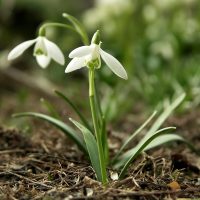 Common snowdrop (Galanthus nivalis)
Common snowdrop (Galanthus nivalis)
When they bloom: February
What to look for: These understated bulbs produce drooping, bell-shaped, snow-white flowers atop short stems.
Native to: Europe
 Daffodil (genus Narcissus)
Daffodil (genus Narcissus)
When they bloom: Mid-February
What to look for: There are many varieties of daffodils, but the most common ones display a trumpet-like flower surrounded by a ring of tepals, often in yellow or white.
Native to: The Mediterranean region
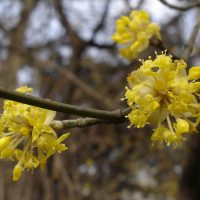 Cornelian cherry (Cornus mas)
Cornelian cherry (Cornus mas)
When they bloom: Late February
What to look for: This dogwood species (not a true cherry) is a large shrub that produces clusters of small, yellow flowers early in the season before its leaves emerge.
Native to: Southern Europe and southwestern Asia
March
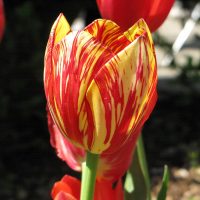 Tulip (genus Tulipa)
Tulip (genus Tulipa)
When they bloom: March to early May, depending on varietal
What to look for: One of the most iconic spring bulbs, the tulip’s distinctive, cup-shaped flowers come in countless colors and patterns thanks to centuries of selective breeding.
Native to: Southern Europe and central Asia
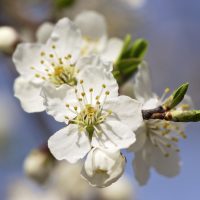 Purple leaf plum (Prunus cerasifera)
Purple leaf plum (Prunus cerasifera)
When they bloom: Early to mid-March
What to look for: This is one of the earliest trees you’ll see blooming in large numbers around Puget Sound, with lots of small, fragrant, white or pale pink flowers.
Native to: Southeast Europe, western Asia
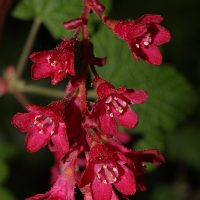 Red-flowering currant (Ribes sanguineum)
Red-flowering currant (Ribes sanguineum)
When they bloom: Early to mid-March
What to look for: This west-coast native shrub produces dangling clusters of red flowers, or racemes, that are a favorite of hummingbirds, butterflies and bees in early spring.
Native to: Western North America
 Cherry (Prunus subgenus Cerasus)
Cherry (Prunus subgenus Cerasus)
When they bloom: Late March
What to look for: You can find countless varieties of “true cherries” in Seattle, but perhaps the most famous are the Japanese cherry trees on the UW Quad, which produce huge quantities of pink, aromatic blossoms in March.
Native to: Asia, North America, North Africa and Europe
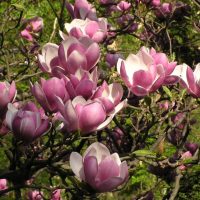 Chinese magnolia (Magnolia x soulangeana)
Chinese magnolia (Magnolia x soulangeana)
When they bloom: Late March to early April
What to look for: This hybrid magnolia tree, also known as the saucer magnolia or tulip magnolia, sends out large (4-8 inches across) pink, maroon and white flowers on its leafless branches.
Native to: China
 Callery pear (Pyrus calleryana)
Callery pear (Pyrus calleryana)
When they bloom: Late March to early April
What to look for: A medium-sized deciduous tree, the Callery pear produces clusters of small, white flowers while its leaves are still developing.
Native to: China and Vietnam
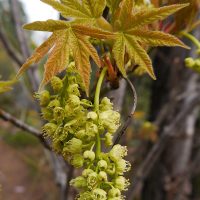 Bigleaf maple (Acer macrophyllum)
Bigleaf maple (Acer macrophyllum)
When they bloom: March through April
What to look for: Though this staple of the Pacific Northwest is most famous for its enormous leaves, the clusters of small, pale green flowers it sends out alongside the young leaves are equally fascinating.
Native to: Western North America
April
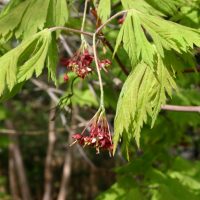 Full-moon maple (Acer japonicum)
Full-moon maple (Acer japonicum)
When they bloom: Early April
What to look for: Take a close look at this Japanese maple in the spring and you’ll be treated to dainty clusters of small, deep red flowers, often crawling with happy bees and hummingbirds.
Native to: Japan, Korea
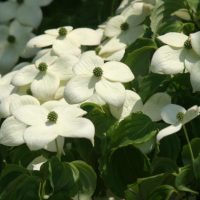 Korean dogwood (Cornus kousa)
Korean dogwood (Cornus kousa)
When they bloom: Late April to early May
What to look for: Notable for producing its blossoms well after its leaves have filled out, this medium-sized dogwood tree develops white, modified leaves, known as bracts, in groups of four in late spring.
Native to: Korea, China and Japan
May
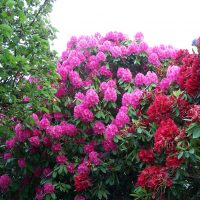 Rhododendron (genus Rhododendron)
Rhododendron (genus Rhododendron)
When they bloom: Early May
What to look for: Many varieties of Washington’s state flower (and its relative, the azalea) grow in the UW Botanic Gardens’ Rhododendron Glen, where their blooms vary widely in size and shape, with most being white, pink or red in color.
Native to: North America, Europe and Asia
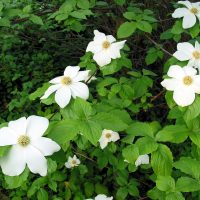 Pacific dogwood (Cornus nuttallii)
Pacific dogwood (Cornus nuttallii)
When they bloom: Late May
What to look for: The Pacific Northwest’s native dogwood is a later bloomer than most, making its large, white flowers even more prominent in late spring.
Native to: Western North America

